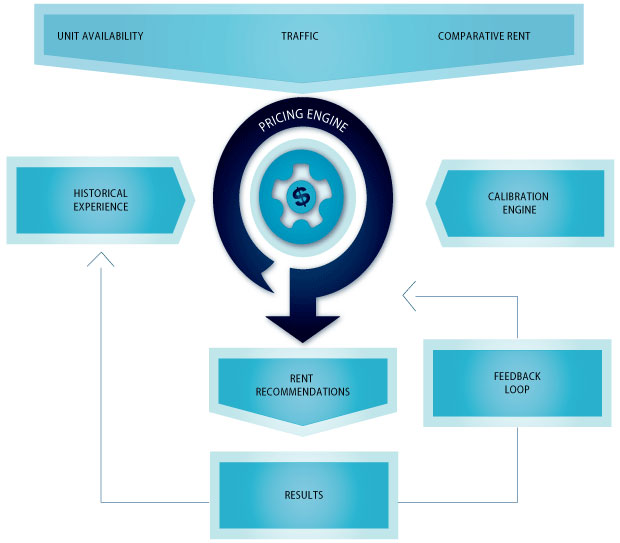
If you’ve been in the market for almost anything recently, you’ve probably noticed price fluctuations. You place a bicycle on your Amazon wish list at one price, only to see it shoot up a hundred dollars more a few days later, then drop to a hundred less a week or so after that. Everything from airplane tickets to apartment rentals seems subject to dramatic price changes from one day to the next.
The way that these price changes are accomplished is through algorithms — complex computerized step-driven formulas that crunch variables related to product and market, then spew out answers.
Algorithms have been around for a while. The ancient Greek mathematician, Euclid, used one around 300 B.C. to find the greatest common divisor of two integers in his geometry work Elements, considered a standard for logical thinking.
All About Adaptability
One historically growth-challenged sector — the multifamily residential dwelling industry, colloquially known as “apartments” — has embraced the algorithm with impressive results.
How do you financially grow buildings that are getting older? The answer is through a combination of things: customer service (note the bend-over-backwards building staff); presentation (lush landscaping and grounds upkeep); and what we’re interested in, which is tech-driven, computer-led pricing.
Algorithm-driven revenue management software like provides a fluid means for adjusting prices based on a host of variables.

For example, RENTmaximizer, which is used to manage 8 million residential units around the world, “adjusts to the changes in the supply and demand of the asset on a daily basis,” said Dharmendra Sawh, Yardi’s industry principal for revenue management.
It “moves the pricing accordingly, to capture the value of the change — whether up or down — to maximize the revenue collected while minimizing vacancy loss, leading to bigger margins,” he told TechNewsWorld.
Rents are priced by the algorithm every day, which provides rapid adjustment to market conditions and changes in traffic or inventory, said Sawh. The product also adjusts for industry-specific cost issues, including vacancy loss and inventory hold periods.
Yardi can distribute information using Microsoft’s Sharepoint and reckons its clients gain about a 2-4 percent lift in net revenue over market.
“It adapts to each asset’s strengths to optimize the value of each lease in an open and transparent way,” Sawh said.
Data on Demand
About a million multifamily housing units are priced using Rainmaker LRO (Lease Rent Options).

Hundreds of variables are included in the data set used to deliver optimized pricing recommendations for apartment owners and operators, said Amar Duggassani, executive vice president, strategy and business development, for Rainmaker LRO.
The variables range from “primary data elements such as lease terms, move-in dates and competitor rents to some highly technical parameters that influence how dynamic our predictive algorithms need to be for a given market,” he told TechNewsWorld.
Rainmaker LRO calculates demand in a given market using all customer visits, even if a unit isn’t leased, and provides forecasting of unconstrained demand — the quantity that could be sold if there weren’t any constraints — which it says is true demand.
It also considers historical price and availability constraints, along with elements such as traffic, leases, notices, move-ins and move-outs.
Feeding the Data Beast
Statistical algorithm-driven RentPush.com is an on-demand, price setting, Web-interfaced application that takes into account historical leasing factors, rent roll, regional trends and other factors.
“Behind the scenes, the RentPush.com algorithm continuously learns, analyzes and responds to incremental changes in vital property performance data such as occupancy, availability and turnover,” said Laurie McMoran Bennett, director of revenue at Spherexx.
Other Spherexx Web-based products — including its CRM tool, ILoveLeasing.com, and its business intelligence product,MarketSurveyTools.com — provide ongoing data for the algorithm as well.
“With RentPush.com, new pricing can be generated and published on demand, at any time,” Bennett said.
Rainmaker LRO will be adding public data sets down the line to refine the algorithms, said Duggassani. At present, it collects most of its data from point-of-sales systems. It also gathers competitor information from third-party data.
Some of this data changes as often as every hour, Duggassani told TechNewsWorld.
Revenue management and price optimization have a long history in the airline industry, he noted, dating back many decades. It isn’t all for the benefit of the operator, either. Pricing efficiency in markets can trickle down to the consumer as well.
“Rainmaker LRO was the first product designed and developed from ground up taking some of the principles from the travel-related businesses and coupling them with more recent advancements to address the unique needs of the multifamily housing industry,” said Duggassani.
“While revenue management is generally credited with generating higher revenues for operators, its true value is in making markets efficient by offering many options for both the suppliers and the consumers,” he said.
In other words, the prices go down as well as up.




















































